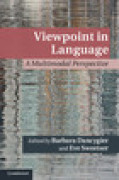
Provides a new understanding of the role and structure of viewpoint in cognition and communication. This volume argues that human cognition is not only rooted in the human body, but also inherently 'viewpointed' as a result; consequently, so are language and communication. It uncovers surprising functional similarities across various communicative forms and provides a new understanding of the role and structure of viewpoint. This volume argues that human cognition is not only rooted in the human body, but also inherently 'viewpointed' asa result; consequently, so are language and communication. It uncovers surprising functional similarities across various communicative forms and provides anew understanding of the role and structure of viewpoint. What makes us talk about viewpoint and perspective in linguistic analyses and in literary texts, as well as in landscape art? Is this shared vocabulary marking real connections between the disparate phenomena? This volume argues that human cognition is not only rooted in the human body, but also inherently 'viewpointed' as a result; consequently, so are language and communication. Dancygier and Sweetser bring together researchers who do not typically meet on common ground: analysts of narrative and literary style, linguists examining the uses of grammatical forms in signed and spoken languages, and analysts of gesture accompanying speech. Using models developed within cognitive linguistics, the book uncovers surprising functional similarities across various communicative forms, arguing for specific cognitive underpinnings of such correlations. What emerges is a newunderstanding of the role and structure of viewpoint and a groundbreaking methodology for investigating communicative choices across various modalities anddiscourse contexts. INDICE: Introduction: viewpoint and perspective in language and gesture, from the ground up Eve Sweetser; Part I. Intersubjectivity and Subjectification: 1. Irony as a viewpoint phenomenon Vera Tobin and Michael Israel; 2. Subjectivity and upwards projection in mental space structure Lilian Ferrari and Eve Sweetser; 3. Negation, stance verbs, and intersubjectivity Barbara Dancygier; Part II. Gesture and Processing of Visual Information: 4. Interactions betweendiscourse status and viewpoint in co-speech gesture Fey Parrill; 5. Maybe what it means is he actually got the spot: physical and cognitive viewpoint in a gesture study Shweta Narayan; Part III. Multiple Viewpoints in American Sign Language: 6. Reported speech as an evidentiality strategy in American sign language Barbara Shaffer; 7. Two ways of conceptualizing space: motivating the useof static and rotated vantage point space in ASL discourse Terry Janzen; PartIV. Constructions and Discourse: 8. The constructional underpinnings of viewpoint blends: the Past+now in language and literature Kiki Nikiforidou; 9. Evoking discourse spaces in speech and thought representation Lieven Vandelanotte;Conclusion: multiple viewpoints, multiple spaces Barbara Dancygier.
- ISBN: 978-1-107-01783-2
- Editorial: Cambridge University
- Encuadernacion: Cartoné
- Páginas: 254
- Fecha Publicación: 12/04/2012
- Nº Volúmenes: 1
- Idioma: Inglés
